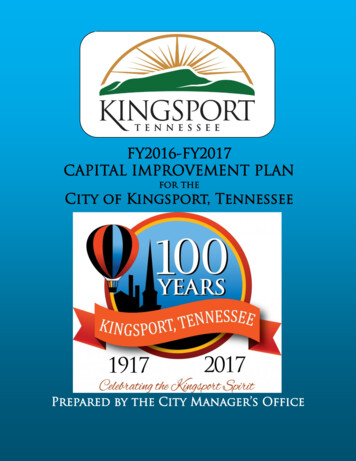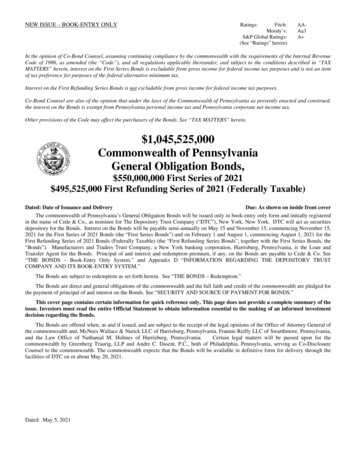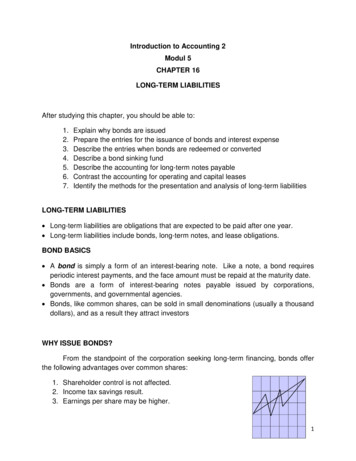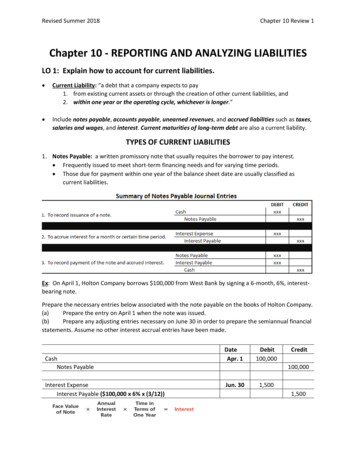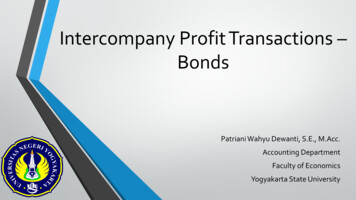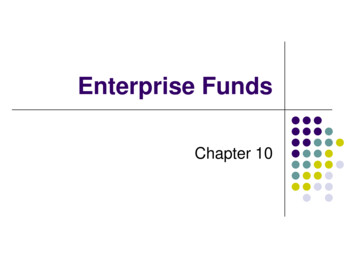
Transcription
FIN 302Class NotesChapter 5: Valuing BondsWhat is a bond? A long-term debt instrument A contract where a borrower agrees to make interest and principalpayments on specific datesCorporate Bond Quotations Coupon rate (on annual basis). Coupon payments are interest paid on the bondusually semiannually. Coupon payments Coupon rate*face value Maturity date : in that date the firm pay the principal or the face amount plus thelast interest payment due Face amount (usually 1000) Volume of trading (in 1000s dollars of the face amount of debts) last price (in % of the face value ) (100.614% Î last price 1.00614*1000 1,006.14) Yield to maturity (the return investor will get if she hold the bond until maturity)Features of Long-Term Bonds1- Par Value: The stated face value of the bond. It is the amount borrowed andthe amount repaid at maturity. Usually par value 10002- Coupon Rate : stated interest rate (generally fixed) paid by the issuer everyperiod. Coupon payment each period Coupon Rate * par value.¾ Floating rate bonds have interest rates that are reset periodically to matchthe general level of interest rates.¾ Zero coupon bonds pay no coupon interest, but they are sold at a deepdiscount below par.3- Maturity: The number of years until the par value is paid off.1
4- Yield to Maturity: Rate of return earned on a bond held until maturity.It also can be called the required rate of return by the lender.¾ When a coupon bond is issued, the coupon rate is usually set to equalthe required market rate of return (kd). A bond’s coupon rate never changes.However, the market rate can fluctuate over time, and this can greatly affectthe bond price¾ If coupon rate yield to maturity then bond is sold at par¾ If coupon rate yield to maturity then bond is sold at premium(bond price par value).¾ If coupon rate yield to maturity then bond is sold at discount(bond price par value).5- Call Features: This is an option given to the issuer (borrower) by which theborrower can redeem the bond before maturity at specified price.¾ If the bond is paid off early, the company must pay a little more than parvalue. That extra amount is a call premium.¾ Usually firms have to wait some time before they are able to call bonds(deferred call ).¾ A call provision is an advantage for the bond issuer and a disadvantage forthe bondholder.¾ The return on callable bonds is higher than the return on noncallablebonds (why?).¾ Bonds are most likely to be called when interest rates in the market dropsignificantly. (why?) bond refunding (refinancing).7- Put Feature: Putable bonds are bonds that allow the bondholder (lender) theoption to sell the bond back to the issuer before maturity at a predeterminedprice.¾ A put feature is an advantage for the bondholder and a disadvantage for thebond issuer.¾ The return on putable bonds is lower than the return on nonputable bonds(why?).¾ Bonds are most likely to be put when interest rates in the market risesignificantly. (why?) (reinvestment).8- Convertible bonds : Allow the bondholder to exchange her bonds (priced atpar) for common stock at pre-specified conversion price.2
Bond RatingsInvestment grade bondsQualityS & P’sMoody’sHighestAAAAaaHighAAAaUpper DefaultD Bond ratingsmeasuredefault risk,so they affectthe bond’sinterest rateand the firm’scost of debt.Higher rated bonds generally carry lower market yields.Interest rate spread between ratings is less during prosperity than duringrecessions.Junk bonds typically yield 3% more than investment grade bonds.Junk bond is of companies with weak financial positions– Highly leveraged– Low earnings3
Bond Valuation: Value of an AssetBased on the expected future benefits over the life of the assetFuture benefits cash flows ( CF’s )Capitalization of cash flow method¾ PV of the stream of future benefits discounted at an appropriaterequired rate of return0124nC4C3C2C1Value 3M CnC1C2Cn M . (1 k d )1(1 k d ) 2(1 k d ) nnCt 1(1 k d )P0 t M(1 k d )nThe Value of a Bond is the Present value of its Cash FlowsAll we have to do is find the PV of all cash flows produced by the bond.Using Calculator:i is the market interest rate that is offered on the bond orit is yield to maturity of the bond (Kd) (not necessarily the coupon rate!)N # of years until maturityPMT Coupon payment (Coupon rate) (Par value) ÎFV par value (maturity value)PV0 ?4
Problem:Find the value of a 1,000, 8% coupon bond with a maturity of 15 years.(Market int. rate 10%.)Solution:List inputs:i 10%N 15PMT Coupon payment 0.08*1000 80FV par value 1000Price of the bond PV0 ?P0 80( PVIFA10,15 ) 1000( PVIF10,15 ) 847.88Remember, i and n are adjusted for more frequent discountingFor example if coupon payments are paid semiannual, then (m 2)New n Î n*mNew iÎi/mNew Coupon rate Î coupon rate /mSemiannual Interest PaymentsProblem:Find the price of a 8% coupon bond (semi-annual payments) with a parvalue of 1,000 and a 15-year maturity if the market rate on similarbonds is 10%.Periods are half-years!Seminanal paymentsÎm 2I 10%/2 5%N 15*2 30Coupon rate 8%/2 4%5
List inputs:i 5%N 30PMT 0.04*1000 40FV par value 1000Price of the bond PV0 ?P0 80( PVIFA5,30 ) 1000( PVIF5,30 ) 846.28Yield to Maturity (YTM): The rate of return earned on a bond if it is held tomaturity.Problem:Suppose you have the following about a bond:Price 1,494.96 Î(PV0)Par Value 1,000.00 Î(FV)Coupon Rate 10% ÎPMT 0.1*1000 100N 14 Î(n)Find the YTM Îfind( i)Use financial eld to Maturity is The discount rate kd that equates the PV of all expectedinterest payments and the repayment of principal from a bond to the presentbond price. In other words: it is the return that you are going to get if you holdthe bond until maturity.6
Key Determinants of Bond Yields1-Risk-free rate of returnNominal risk-free rate rf is a function of:¾ Inflation premiumi n :compensation for inflation and lowerpurchasing power.¾ Real risk-free raterf′ : compensation for postponing consumption.(1 rf ) (1 rf′ )(1 i n )rf rf′ i n rf′i nrf rf′ i n2-Risk premium¾ Maturity (term structure of interest rate)¾ Default¾ Interest rate risk7
Current YieldTakes into account only the interest payment portion of the returnCurrent yield (CY) Annual coupon paymentCurrent priceBond Pricing Principles1. Bond values are inversely related to the required rate of return2. Bonds trade at a discount, par, or premium3. The sensitivity of bond prices to a given change in the required rate ofreturn¾ Increases with the maturity of the bond4- The sensitivity of bond prices to a given change in the required rate ofreturn decreases the higher the coupon rate.8
Bond Valuation: Value of an Asset Based on the expected future benefits over the life of the asset Future benefits cash flows ( CF's ) . Use financial calculator: Compute 5% Yield to Maturity is The discount rate kd that equates the PV of all expected





